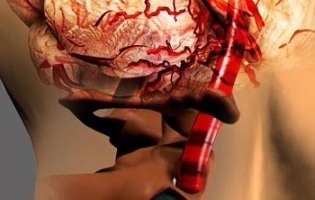
Symptoms of cervical spine osteochondrosis can occur at any age. Most often, the disease occurs in the elderly, and only lesions of the neck can not be observed. However, at present, exacerbation of cervical dystrophic processes is observed mainly in young people engaged in mental work. It should be understood that cervical osteochondrosis is very difficult to treat completely, but it can stop its development and significantly improve a person's well-being.
Causes and mechanism of formation
Cervical dystrophic processes begin slowly. The most important causes of the disease are a sedentary lifestyle and disorders of some mineral metabolism.
If you eliminate the causes of osteochondrosis of the neck, it will be very successful to treat some of its manifestations. Otherwise, if the cause continues to act, the person's condition will only worsen.
The following changes occur under the influence of the root cause of osteochondrosis of the neck:
- The starting point is a blockage in the lymphatic and circulatory system;
- then there are degenerative and destructive changes in the intervertebral disc that act as a shock absorber between the vertebrae; height and plasticity decrease;
- After a while there is an increase in the bone tissue of the spine;
- All this leads to limited mobility of the spine, increased pressure on the vessels and nerves passing through the spinal apparatus.

The sooner appropriate treatment is started, the better the chances of slowing the progression of the disease and even completely curing the person.
Complications of the disease can be triggered by any external or internal influences. It can be a viral infection, cold temperature, significant physical activity, or even an increase in atmospheric pressure. The stronger the cause of the exacerbation, the more obvious the symptoms of the disease.
Features of cervical osteochondrosis
The symptoms of cervical osteochondrosis gradually increase, at the beginning of the disease the patient is practically not bothered. Dizziness can be noted only occasionally. However, cervical osteochondrosis cannot be ignored: it is difficult to eliminate the symptoms in the later stages of the disease.
Since the cervical spine is directly connected to the brain, there will be numerous complaints from the central nervous system when there are degenerative changes in this area. This is due to a gradual and increasing deterioration in the blood circulation and metabolic diseases in the brain.
Many patients may initially have symptoms of brain damage:
- sudden changes in blood pressure;
- dizziness;
- temporary burning and diffuse headache;
- The temperature rises slightly to low numbers.
In addition to the above symptoms, there are signs of damage to the neck itself:
- pain that eventually begins to spread to the back of the head, arms, and back;
- limited mobility, cracking, tingling, numbness or burning in the neck when bowing or turning;
- body temperature is normal.
As osteochondrosis progresses, the person's condition will worsen, the inflammation will become more frequent and intense, it will be very difficult to treat the person completely over time, and it will be possible to alleviate the pain a little.
Unlike inflammatory processes, temperature rarely changes. In the later stages of cervical osteochondrosis, the exacerbation is virtually non-existent, and there will be serious damage to the brain and spinal cord:
- jump in blood pressure or persistent high blood pressure;
- persistent dizziness and headache, slightly worsening;
- pain, burning and restriction of neck mobility;
- body temperature may rise slightly, but remains more normal.

Vertebral artery damage syndrome is a very common degenerative-dystrophic process that occurs in the middle of the neck. Such a person almost always feels a throbbing headache, pressure and burning in the temples, congestion and tinnitus, while turning his head - dizziness and even fainting. It is almost impossible to treat vertebral artery compression syndrome.
In some people, on the contrary, you may notice signs of damage to the upper extremities (with predominant changes in the cervical and brachial plexus):
- burning or numbness in all parts of the upper extremity;
- dizziness is rare;
- Decreased skin temperature.
The consequences of osteochondrosis can be very serious: constant headaches and dizziness, poor memory and attention, numbness of the whole neck.
Treatment methods
Almost complete restoration of the initial state of the osteoarticular apparatus can be achieved only in the early stages of osteochondrosis and after the removal of the cause. Exacerbation of the disease requires more intensive treatment. In the later stages, the goal of treatment is to relieve pain, dizziness, and inflammatory changes. You can treat cervical osteochondrosis with the following tools:
- chondroprotectors to restore the original structure of the cartilage tissue of the intervertebral disc;
- non-steroidal anti-inflammatory drugs (NSAIDs) for pain and inflammation;
- multivitamin complexes with high content of vitamin B to improve the trophism of nerve tissue;
- nootropics to correct serious disorders in brain tissue;
- complex of physiotherapy exercises and massage (unless severe dizziness and high blood pressure occur);
- physiotherapy (water, iontophoresis, magnetotherapy), the temperature and pressure of the factor should be high enough, and combustion is considered a positive effect.
Much depends on the patient in the treatment of osteochondrosis. The sooner the necessary therapy is started, the more carefully a person follows the doctor's prescriptions, the greater the chances of success and a decent quality of life for the patient.



































